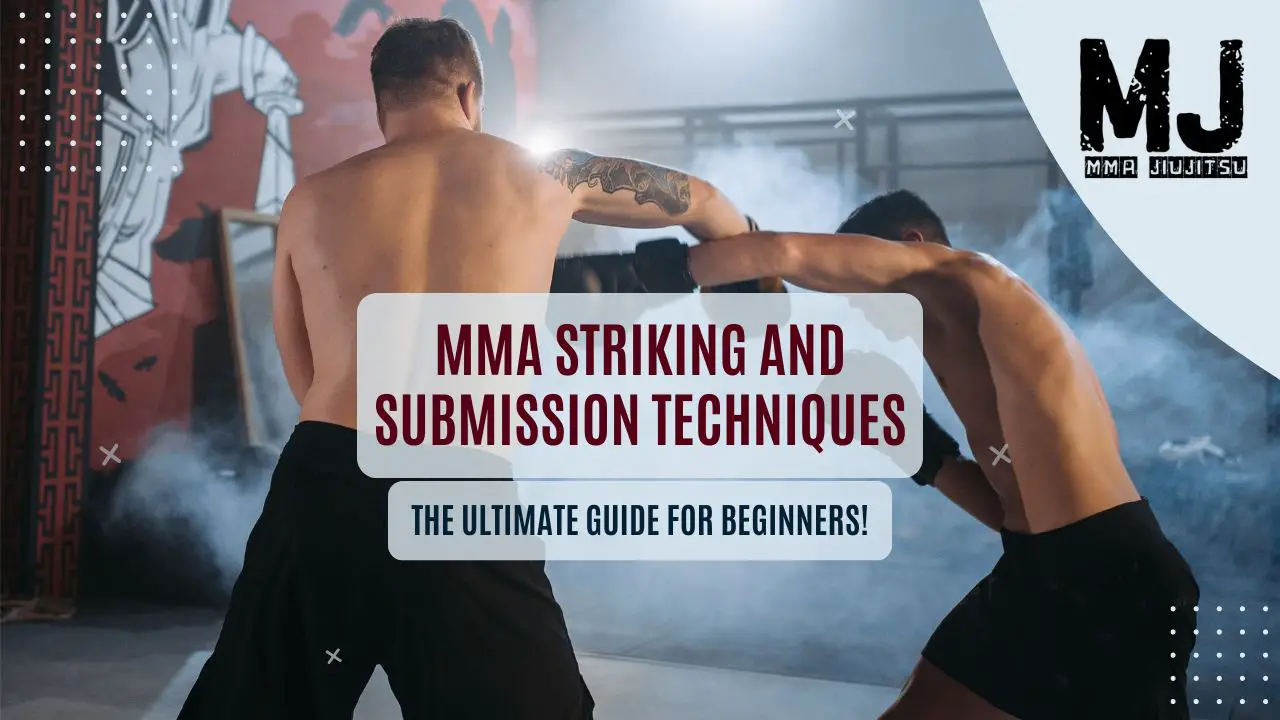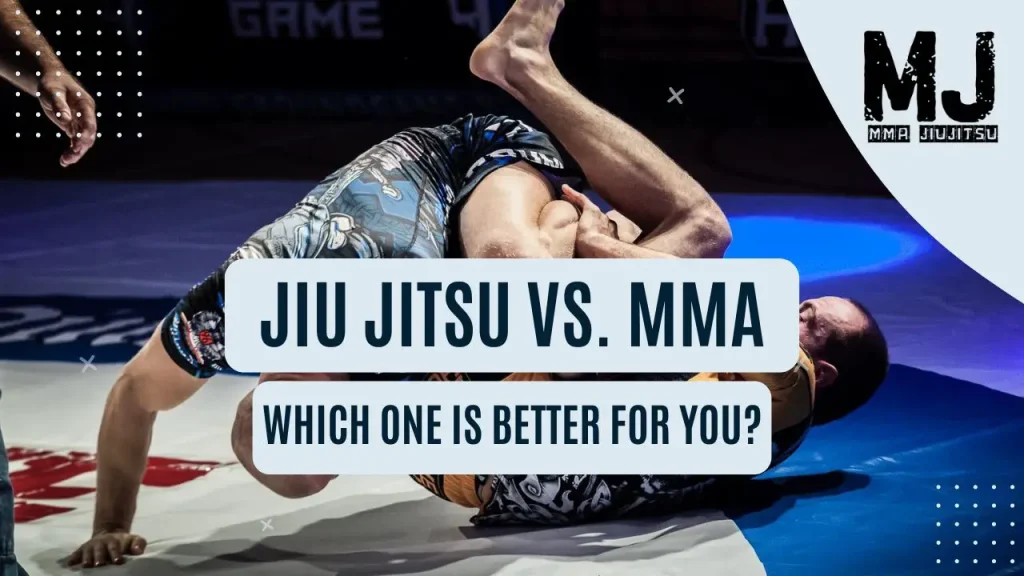MMA is an exciting combat sport that combines several striking and submission techniques.
If you’re a beginner, you must learn the basic principles of striking and submission to develop a well-rounded fighting skill set.
This article will cover the fundamental techniques of MMA striking and essential submissions. So you’ll establish a strong foundation and start your MMA journey confidently.
Importance of MMA Striking and Submission Techniques

Mixed martial arts (MMA) is a combat sport that incorporates techniques from different disciplines, such as boxing, wrestling, judo, jiu-jitsu, and karate.
Striking techniques can strategically knock out an opponent without submitting them.
While submission allows for a quick finish, strikes can destabilize an opponent, making victory more attainable.
Submissions have been pivotal in MMA since Royce Gracie’s fight in the Ultimate Fighting Championship, shifting the sport’s dynamics.
Submissions are a tactful way to end a fight swiftly, and approximately 20% of all UFC wins are attributed to submission finishes.
MMA Striking Techniques

Striking techniques are a compulsory part of MMA.
They make MMA more interesting and exciting than other martial arts. Though it is termed violent, striking is fun in MMA.
Striking originated from other fighting disciplines, such as boxing and kickboxing.
Here are some of the basic strikes in mixed martial arts.
Elbow Strikes
Originally, elbow strikes were a part of Muay Thai, inculcated in MMA.
These strikes are pretty dangerous as most MMA fighters suffer from cuts, especially head cuts that are a result of elbow strikes.
When applying elbow strikes, fighters need to watch their stance and keep their hands slightly higher than usual.
Hitting the rear elbow across your opponent’s face can be devastating for him and can knock him out in seconds.
There are approximately eight types of elbow strikes that can easily award you victory:
- Slashing Elbow
- Uppercut Elbow
- Chopping Elbow
- Horizontal Elbow
- Smash Downward Elbow
- Spinning Elbow
- Double Elbows
- Diagonal Elbow

Punches
To apply punches, you need to develop excellent body strength.
This will strengthen your punches, and your opponent cannot overcome them.
The thing that matters the most is your speed.
Landing punches very fast will reward you with a KO win via punches.
- Hook Punch: You must shift your weight on one leg and lift the other foot from the ground, turn around, and punch with full force.
- Uppercut Punch: You must make a 90° angle with your arm and punch below the opponent’s chin as if he’s looking at the sky.
- Cross Punch: It is also known as straight right hand. Punch on your opponent’s face as if making a straight line. The main target of this punch is your opponent’s jaws.
Jabs
Jabs and punches are often referred to as the same thing. However, there is a minute difference between the two.
Punches are thrown in a slight circular motion, whereas jabs are thrown in a straight line.
There are a few types of jabs based on the position from which they are applied.
- Jab for the stop
- Jab with full crouch
- Jab with counterpunch
- Jab with side stance

Leg Kicks
Leg kicks are the most dangerous attacks in MMA.
They are the game changers in MMA. You can imbalance your opponent and lead him to a deadly takedown.
Leg kicks slow your opponent and interrupt their mobility.
- Shin Kicks
- Outside Leg Kicks
- Calf Kicks
- Inside Leg Kicks
- Sidekicks
- Spinning Back Kicks
- Roundhouse Kicks
Most Successful Submissions in MMA
The following are the most utilized and successful submissions in MMA:
Rear Naked Choke
The rear naked choke is considered the most lethal blood choke in martial arts.
It is applied from the back mount position, which gives the fighter leverage and makes it difficult for the opponent to anticipate the move.
This technique is called a blood choke because it restricts the flow of blood to the brain, which, if executed correctly, can lead to unconsciousness.
It is also known as a naked choke because it can be performed without the use of a gi.
This sets it apart from other Brazilian Jiu-Jitsu submissions, such as the cross-collar choke, which requires the presence of a gi.

Guillotine Choke
The guillotine choke applies pressure to the opponent’s carotid arteries.
This submission forces the opponent to tap out when the position gets locked.
The guillotine is also called an air choke when your forearm suppresses your opponent’s windpipe.
It can be applied from various positions, giving it several variations, such as arm in guillotine, one-handed guillotine, and 10-finger guillotine.
Triangle Choke
The triangle choke is the most effective, as it takes only 9.5 seconds to make your opponent unconscious.
It is called a triangle choke because you need to create a triangle shape to lock the submission.
The triangle choke is a blood choke because it blocks blood flow to the brain. Establishing wrist control is the most essential step in securing the choke.
Armbar
Armbar is the most applied submission in MMA.
This is because the armpit is a fighter’s weakest part. Slight pressure on the armpit and shoulder joint allows you to submit your opponent.
The armbar has many variations, such as the flying, basic, inverted, and many more.

Arm Triangle Choke
Arm triangle choke restricts blood flow from both sides of the neck to the brain.
Instructors often advise tapping as soon as the fighter feels slight pain.
It is the most advanced version of triangle choke because it constricts the opponent’s head and arm, reducing his movements to zero.
Combining Striking with Submissions
Combining striking with submissions is a crucial skill in MMA.
It keeps opponents off balance and allows fighters to execute submissions effectively, whether standing or on the ground.
This strategy enhances offensive and defensive capabilities, making fighters a formidable competitor in any area.
Setting Up Submissions with Strikes
Using strikes to set up submissions can be effective in combat sports.
By utilizing your striking abilities, you can make your opponent move defensively or commit mistakes, creating opportunities for submission holds.
For instance, a perfectly timed uppercut can make your opponent lift their arms to shield their face, exposing their torso.
This opening can be exploited for a takedown or clinch, which can then be used to initiate a submission.

Transitioning from Striking to Grappling
It’s important to have fluid movements and anticipate your opponent’s moves to transition effectively from striking to grappling.
It is highly beneficial to Combine punching combos with clinch attempts or takedown drills.
Switching effortlessly between striking and grappling, even under pressure, is a precious skill in MMA.
It allows you to adapt to any situation during a fight and can give you an edge over your opponent.
Conclusion
When starting your MMA journey, it is crucial to master both striking and submission techniques.
Consistent practice and dedicated training are essential for developing these skills.
Remember, the journey in MMA is as challenging as it is rewarding, and every training session is a step towards becoming a more skilled martial artist.
Frequently Asked Questions
Which is More Effective: Striking or Submission Techniques?
Striking and submission techniques are both effective in their own way.
When applied correctly and with the proper force, it declares you the winner within seconds.
Can a Fighter Tap Out After Receiving a Punch or Kick?
A fighter can tap out after receiving a hard blow or kick.
In that case, the other fighter will be declared the winner via submission kicks or punches.



